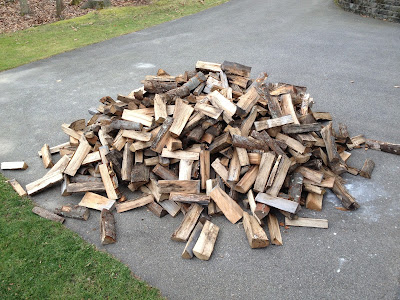The new stove gets installed tomorrow. We anticipate it like the arrival of a newborn or a new puppy. We've talked with friends about how to best operate the stove, tools needed, and much more. Mostly though, we've been obsessed with firewood.
Months before we decided to buy a wood stove, we started gathering wood from our own small 1.5 acres. A few years ago we had the big pines removed to allow more sunlight to the house and driveway, to guard against a tree falling on the house, and to allow the remaining hardwoods to grow bigger. We continue to thin the woods here and there, as trees are damaged by storms (which seem to occur quite regularly). In all, we've scraped together about one-half cord.
As we approached the installation date, we needed to buy-in much more wood and now have two more cords of seasoned hardwood stacked in various places. We've paid $300 to $325 for each cord of seasoned and delivered wood, and likely we'll need at least one more cord to get us through the cold season.
A loose pile of firewood - one cord waiting to be stacked
Here are our various stacks of firewood using different methods: 2x4 end frame, metal end frame, and tying string around the end logs to hold the pile together. I like the metal end frames with 10-foot pressure-treated 2x4s (the top photo). It is the most sturdy and least amount of work.Some day we'll build a woodshed to store wood that we can season ourselves, which saves a lot of money (except for the cost of building the woodshed!). Srini has already built an indoor wood box for the basement--a staging area for a week's worth (or so) of dry wood.
As a wildlife biologist I look at trees and forests as habitat. Big gnarly trees, standing dead trees ("snags"), fallen trees, stumps, trees with cavities--all have extraordinary value for wildlife as nest sites, denning areas, and as feeding or resting areas. Dead and dying trees are a boon to wildlife--full of insects that birds and mammals and other creatures feed on. As a biologist I work with landowners on managing their lands for wildlife and other ecological values. I extoll the virtues of big trees, trees with cavities, dead trees, dying trees, fallen trees, messy tangles of trees.
Now that we will have our own wood stove, I am looking twice at all the trees. I eye them for firewood, but also think about the wildlife. We need to ask our firewood supplier where he gets his wood - is it from lands being managed sustainably? We want to be good stewards of our own little woodland as well as of the lands where most of our wood comes from.
One of many reasons we opted for a wood stove, was to reduce our reliance on non-renewal sources to heat the house. Local wood--a renewal resource--is ideal, as long as we aren't diminishing the productivity or ecological values of the land where it comes from.
The excitement builds as the new wood stove will arrive tomorrow. Stay tuned!







No comments:
Post a Comment